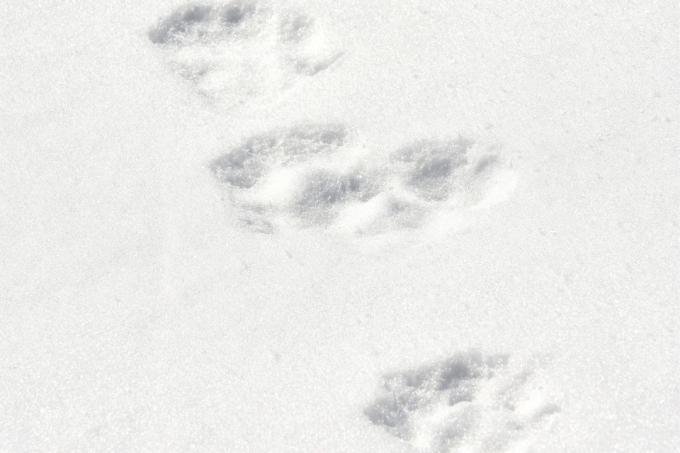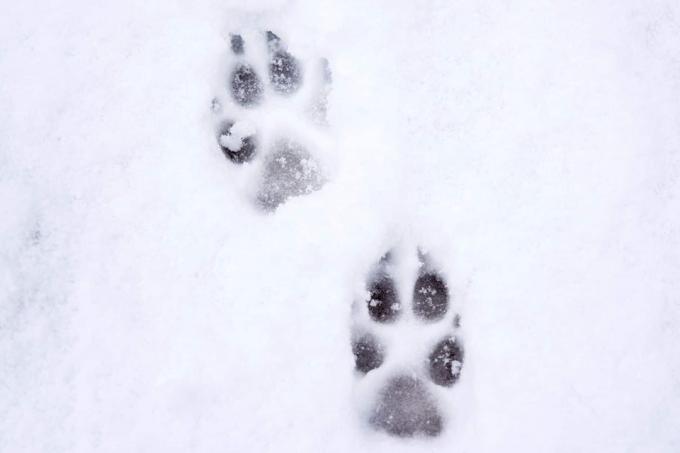
table of contents
- Badger
- squirrel
- hare
- otter
- domestic cat
- domestic dog
- deer
- red fox
- stone marten
- birds
- frequently asked Questions
On a walk in winter, snow-covered meadows and fields are criss-crossed by the clearly visible tracks of many animals. Animal tracks can even be discovered in the snow in your own garden. We help determine them.
In a nutshell
- most common animal tracks in the snow from rabbits, dogs and cats
- Animals that hibernate can leave tracks in the snow when it snows again in spring
- Rabbits and squirrels are recognizable by the typical course of their steps
- Cats and dogs only have four toes
- sometimes other imprints, e.g. B. from the tail, found at Tierspur
Badger
The badger (Meles meles) belongs to family of martens and usually hibernates in winter. However, if it is warm for a long time and then snow comes again, traces of it can also be found in the snow.

- Length: 6.5 to 11 cm
- Width: 6.5cm
- Shape: curved pads, separate print of toes and claws, five toes and claws
- Course: toes slightly turned sideways, step length 25 to 80 cm, steps always staggered
- Occurrence: Extensive mixed deciduous forests, dense shrub layer, hedges, also foraging on agricultural land
squirrel
Squirrels (Sciurus) only stay in winter hibernation. They keep waking up looking for theirs food store up, which they put on in the winter.

- Length: 3.6 to 4.5 cm
- Width: 2.6 to 2.7 cm
- Shape: narrow, pads merge seamlessly into toes, claw print clearly visible
- Course: Stride length up to 93 cm depending on the speed of movement, front and rear feet parallel
- Occurrence: forests, gardens
hare
The animal track of a brown hare (Lepus europaeus) is very easy to recognize. Its typical sequence of movements with two steps in a row and a parallel step with the hind legs is easy to recognize.

- Length: 6.9 to 10 cm
- Width: 3.5 to 6 cm
- Shape: narrow, elongated, occasionally the toes can be seen
- Course: Stride length more than 2 m, depending on speed, front feet in a row in almost one line, rear feet parallel
- Occurrence: Forests, meadows, fields, occasionally also gardens
otter
The otter (Lutra lutra) is very adaptable in its way of life. It is not uncommon for him to dig his burrow in the bank areas, which can then no longer be entered.

- Length: 7 to 7.5 cm
- Width: 6 to 6.5 cm
- Shape: pads like an inverted clover, five toes and claws, toes and claws do not make a separate print
- Course: Stride length 40 to 47 cm, steps staggered, occasional tail track in the middle
- Occurrence: Shore areas, flood plains, occasionally also fish ponds, occasionally also on salt water coasts
Notice: The otter always makes its entrance to the burrow above the flood line. If necessary, they can flee quickly in the event of a flood.
domestic cat
A cat's (Felis catus) tracks are easy to spot as they don't leave claw marks in the snow.

- Length: 4 to 6 cm
- Width: 3.4 to 4.30 cm
- Shape: four toes, no claw marks
- Course: step length 40 to 55 cm, steps staggered
- Occurrence: mainly in settlement areas, occasionally cats also undertake long forays over meadows, fields and in forests
Notice: If you find an above-average cat track in the forest, you should document the track and report it to the nearest nature conservation office. It could very well be a sighting of a lynx or a wild cat, whose population has been increasing again for several years.
domestic dog
Small to very large tracks, which all look similar, can often be found along snow-covered paths. In most cases, these are dogs (Canis lupus familiaris) of different sizes.

- Length: 2 to 8 cm
- Width: 2.5 to 7 cm
- Form: pads prominent, four toes, toes oval, claws close to toes, but mostly with distance
- Course: step length 40 to 120 cm, steps staggered
- Occurrence: everywhere
Notice: If you spot a larger than average footprint, it could be either a very large dog or even a wolf. On average, wolf tracks are at least 10 cm long.
deer
The animal track of a roe deer (Capreolus capreolus) is easy to recognize in the snow, because it is the most common even-toed ungulate in nature. In rare cases, a significantly larger even-toed ungulate track can also be found, which is the animal track of a deer.

- Length: 3 to 4 cm
- Width: 5.5 to 6.5 cm
- Shape: Hooves slightly curved inwards
- Course: step length 70 to 90 cm, steps staggered
- Occurrence: Forests, grasslands, fields, occasionally also gardens
red fox
Finding a fox track in the snow is not that rare anymore. the Fox (Vulpes vulpes) has long since become a cultural successor and can even be found in cities.

- Length: 4.5 to 5 cm
- Width: 4 to 4.5 cm
- Shape: four toes, claws slightly curved inwards on the outside, the two middle claws almost next to each other
- Course: step length 65 to 75 cm, steps staggered
- Occurrence: Forests, grasslands, fields, descendants of cultures
stone marten
stone marten (Martes foina) have very large territories. In order to conserve resources in winter, they usually do not cover such large distances at this time of year.

- Length: 4.5 to 5.5 cm
- Width: 5 to 5.5 cm
- Shape: Pads slightly curved, five toes and claws, claws spaced from the toes
- Course: Stride length 40 to 47 cm, steps staggered, occasional tail track in the middle, double jump with almost parallel imprints
- Occurrence: Forests with open clearings or rocky terrain, more often also a cultural successor
birds
Although bird tracks can be seen in the snow, they are usually indistinguishable from each other. A distinction can only be made between larger and smaller bird species.

A particularly interesting bird track is a wing imprint in the snow in winter. Occasionally this can happen when the snow is fresh and not very firm. If a bird has landed in fresh snow and wants to fly again, the wing makes an imprint because the bird has sunk into the snow and is therefore starting from a lower position.
frequently asked Questions
Many animals are active in the early morning hours. Therefore, most of the tracks can be found at this time and with a bit of luck you will not only find the animal track, but you will also be able to observe the animal from which it came.
No, huntable wild animals may not be fed by private individuals in winter. In hunting, caring for game is often already prohibited. Wild animals may only be fed in emergency situations. This prevents wild animals from becoming more and more culture followers.
Basically, the fox does not pose a threat to humans. The risk of infection with the fox tapeworm is also low with average hygiene. However, a fox track can mean that the fox may have found something in the garden or living area that piqued its interest. These can be animals such as chickens, but foxes are also attracted to compost heaps with meat waste or animal feed outdoors.
